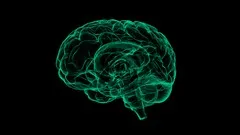
Brain Computer Interface 
Get a comprehesive understanding of Brain Computer Interface. This is a pay course from Udemy. AZ Class provides this course data for free. Learn more certificate and details here. Discover the fascinating world of Brain-Computer Interface (BCI) technology in this captivating course! Unleash the power of your mind as you delve into the direct connection between the human brain and computers. Learn how BCI enables brain signals to control external activities, from manipulating prosthetic limbs to directing a cursor. Explore the history, benefits, and drawbacks of BCI, and gain insights into how their brain functions. Dive into the various components and types of BCI, its applications in both medical and non-medical fields, and the cutting-edge technologies shaping its future. Don't miss this opportunity to unlock the potential of your brain! ▼
ADVERTISEMENT
Course Feature
![]() Cost:
Cost:
Paid
![]() Provider:
Provider:
Udemy
![]() Certificate:
Certificate:
Paid Certification
![]() Language:
Language:
English
![]() Start Date:
Start Date:
2015-03-03
Course Overview
❗The content presented here is sourced directly from Udemy platform. For comprehensive course details, including enrollment information, simply click on the 'Go to class' link on our website.
Updated in [October 07th, 2023]
What does this course tell?
(Please note that the following overview content is from the original platform)
Brain-Computer Interface or BCI is a rapidly evolving technology that builds a direct channel between the human brain and the computer BCI is a technology that enforces a collaboration between a brain and a device that enables signals from the brain to direct some external activity This working together is aimed at either controlling a cursor or manipulating a prosthetic limb The interface facilitates a direct communications path between the brain and the object to be controlled This introductory course will begin discussions on definitions the history benefits and drawbacks of BCI An introduction of how our brain works will also be discussed The succeeding modules will discuss BCI components types BCI in animals and humans medical and non-medical BCI applications BCI technologies and the current and future status of BCI
We considered the value of this course from many aspects, and finally summarized it for you from two aspects: skills and knowledge, and the people who benefit from it:
(Please note that our content is optimized through artificial intelligence tools and carefully reviewed by our editorial staff.)
What skills and knowledge will you acquire during this course?
During this course on Brain-Computer Interface (BCI), learners will acquire the following skills and knowledge:
1. Understanding of BCI: Learners will gain a clear understanding of what BCI is, its purpose, and how it functions as a direct channel between the human brain and a computer or device.
2. Definitions and History: The course will cover the definitions and historical background of BCI, providing learners with a comprehensive overview of its development and evolution.
3. Benefits and Drawbacks: Learners will explore the advantages and disadvantages of BCI technology, understanding its potential benefits in various fields and the challenges it may present.
4. Brain Function: An introduction to how the human brain works will be discussed, providing learners with a foundational understanding of the brain's structure and functions relevant to BCI.
5. BCI Components: The course will delve into the different components that make up a BCI system, including sensors, signal processing algorithms, and output devices, enabling learners to comprehend the technical aspects of BCI technology.
6. Types of BCI: Learners will be introduced to various types of BCI systems, such as invasive, non-invasive, and hybrid BCIs, understanding their differences and applications.
7. BCI in Animals and Humans: The course will explore the use of BCI technology in both animals and humans, highlighting the research and applications in these domains.
8. Medical and Non-Medical BCI Applications: Learners will gain insights into the medical applications of BCI, such as assistive technologies for individuals with disabilities, as well as non-medical applications, including gaming and communication.
9. BCI Technologies: The course will cover different BCI technologies, such as electroencephalography (EEG), functional near-infrared spectroscopy (fNIRS), and invasive neural implants, enabling learners to understand the diverse approaches used in BCI research.
10. Current and Future Status of BCI: The course will provide an overview of the current state of BCI technology, including its limitations and ongoing research efforts, as well as potential future developments and advancements in the field.
Who will benefit from this course?
This course on Brain-Computer Interface (BCI) will benefit individuals and professionals from various interests and specific professions.
1. Researchers and Scientists: Researchers and scientists working in the field of neuroscience, neuroengineering, and biomedical engineering will benefit from this course. It will provide them with a comprehensive understanding of BCI technology, its components, and its applications. They can further explore and contribute to the advancements in this field.
2. Medical Professionals: Medical professionals, including doctors, neurologists, and rehabilitation specialists, can benefit from this course. It will help them understand the potential of BCI in medical applications, such as assisting patients with paralysis or neurological disorders. They can incorporate BCI technology into their practice and provide better care to their patients.
3. Engineers and Technologists: Engineers and technologists interested in developing BCI devices or working on related technologies will find this course valuable. It will provide them with insights into the technical aspects of BCI, including signal processing, machine learning algorithms, and hardware design. They can apply this knowledge to develop innovative BCI systems.
4. Prosthetics Specialists: Professionals involved in the field of prosthetics, including prosthetists and rehabilitation engineers, can benefit from this course. It will introduce them to the concept of using BCI to control prosthetic limbs, enabling more natural and intuitive movements for amputees. They can incorporate BCI technology into their practice and enhance the functionality of prosthetic devices.
5. Ethicists and Policy Makers: Ethicists and policy makers interested in the ethical and societal implications of BCI technology will find this course informative. It will discuss the benefits and drawbacks of BCI, raising important ethical considerations. They can use this knowledge to shape policies and regulations surrounding the use of BCI technology.
Course Syllabus
Introduction to Brain-Computer Interface
Understanding our Brain and Brain-Computer Interface
Types of Brain-Computer Interface
Brain-Computer Interface in Animals
Brain-Computer Interface in Humans
Brain-Computer Interface Applications
Brain-Computer Interface Technology
Current and Future Status of Brain-Computer Interface
Course Resources
Brain Computer Interface Certification
Course Provider

Provider Udemy's Stats at AZClass
Discussion and Reviews
0.0 (Based on 0 reviews)
Explore Similar Online Courses

Training the Athletic Brain

Do It Better Brain Training ++

Python for Informatics: Exploring Information

Social Network Analysis

Introduction to Systematic Review and Meta-Analysis

The Analytics Edge

DCO042 - Python For Informatics

Causal Diagrams: Draw Your Assumptions Before Your Conclusions

Whole genome sequencing of bacterial genomes - tools and applications

WealthyBrainHack - Hack Your Way to An Ultimate Success

Instant Mind Power


Start your review of Brain Computer Interface